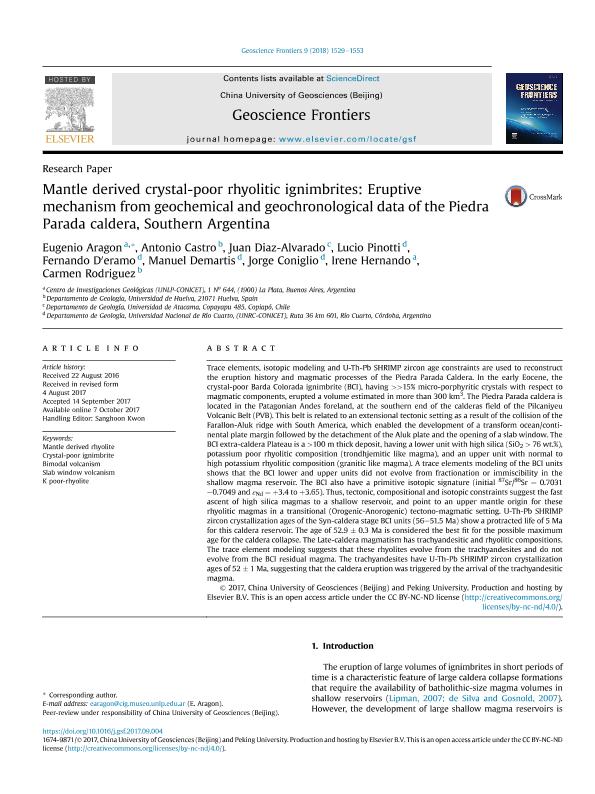Artículo
Mantle derived crystal-poor rhyolitic ignimbrites: Eruptive mechanism from geochemical and geochronological data of the Piedra Parada caldera, Southern Argentina
Aragon, Eugenio ; Castro, Antonio; Diaz Alvarado, Juan; Pinotti, Lucio Pedro
; Castro, Antonio; Diaz Alvarado, Juan; Pinotti, Lucio Pedro ; D'eramo, Fernando Javier
; D'eramo, Fernando Javier ; Demartis, Manuel
; Demartis, Manuel ; Coniglio, Jorge Enrique; Hernando, Irene Raquel
; Coniglio, Jorge Enrique; Hernando, Irene Raquel ; Rodriguez, Carmen
; Rodriguez, Carmen
 ; Castro, Antonio; Diaz Alvarado, Juan; Pinotti, Lucio Pedro
; Castro, Antonio; Diaz Alvarado, Juan; Pinotti, Lucio Pedro ; D'eramo, Fernando Javier
; D'eramo, Fernando Javier ; Demartis, Manuel
; Demartis, Manuel ; Coniglio, Jorge Enrique; Hernando, Irene Raquel
; Coniglio, Jorge Enrique; Hernando, Irene Raquel ; Rodriguez, Carmen
; Rodriguez, Carmen
Fecha de publicación:
12/2017
Editorial:
Elsevier Science
Revista:
Geoscience Frontiers
ISSN:
1674-9871
Idioma:
Inglés
Tipo de recurso:
Artículo publicado
Clasificación temática:
Resumen
Trace elements, isotopic modeling and U-Th-Pb SHRIMP zircon age constraints are used to reconstruct the eruption history and magmatic processes of the Piedra Parada Caldera. In the early Eocene, the crystal-poor Barda Colorada ignimbrite (BCI), having >>15% micro-porphyritic crystals with respect to magmatic components, erupted a volume estimated in more than 300 km3. The Piedra Parada caldera is located in the Patagonian Andes foreland, at the southern end of the calderas field of the Pilcaniyeu Volcanic Belt (PVB). This belt is related to an extensional tectonic setting as a result of the collision of the Farallon-Aluk ridge with South America, which enabled the development of a transform ocean/continental plate margin followed by the detachment of the Aluk plate and the opening of a slab window. The BCI extra-caldera Plateau is a >100 m thick deposit, having a lower unit with high silica (SiO2 > 76 wt.%), potassium poor rhyolitic composition (trondhjemitic like magma), and an upper unit with normal to high potassium rhyolitic composition (granitic like magma). A trace elements modeling of the BCI units shows that the BCI lower and upper units did not evolve from fractionation or immiscibility in the shallow magma reservoir. The BCI also have a primitive isotopic signature (initial 87Sr/86Sr = 0.7031-0.7049 and ε Nd = +3.4 to +3.65). Thus, tectonic, compositional and isotopic constraints suggest the fast ascent of high silica magmas to a shallow reservoir, and point to an upper mantle origin for these rhyolitic magmas in a transitional (Orogenic-Anorogenic) tectono-magmatic setting. U-Th-Pb SHRIMP zircon crystallization ages of the Syn-caldera stage BCI units (56-51.5 Ma) show a protracted life of 5 Ma for this caldera reservoir. The age of 52.9 ± 0.3 Ma is considered the best fit for the possible maximum age for the caldera collapse. The Late-caldera magmatism has trachyandesitic and rhyolitic compositions. The trace element modeling suggests that these rhyolites evolve from the trachyandesites and do not evolve from the BCI residual magma. The trachyandesites have U-Th-Pb SHRIMP zircon crystallization ages of 52 ± 1 Ma, suggesting that the caldera eruption was triggered by the arrival of the trachyandesitic magma.
Archivos asociados
Licencia
Identificadores
Colecciones
Articulos(CIG)
Articulos de CENTRO DE INVEST.GEOLOGICAS (I)
Articulos de CENTRO DE INVEST.GEOLOGICAS (I)
Citación
Aragon, Eugenio; Castro, Antonio; Diaz Alvarado, Juan; Pinotti, Lucio Pedro; D'eramo, Fernando Javier; et al.; Mantle derived crystal-poor rhyolitic ignimbrites: Eruptive mechanism from geochemical and geochronological data of the Piedra Parada caldera, Southern Argentina; Elsevier Science; Geoscience Frontiers; 8; 4; 12-2017; 1-26
Compartir
Altmétricas



